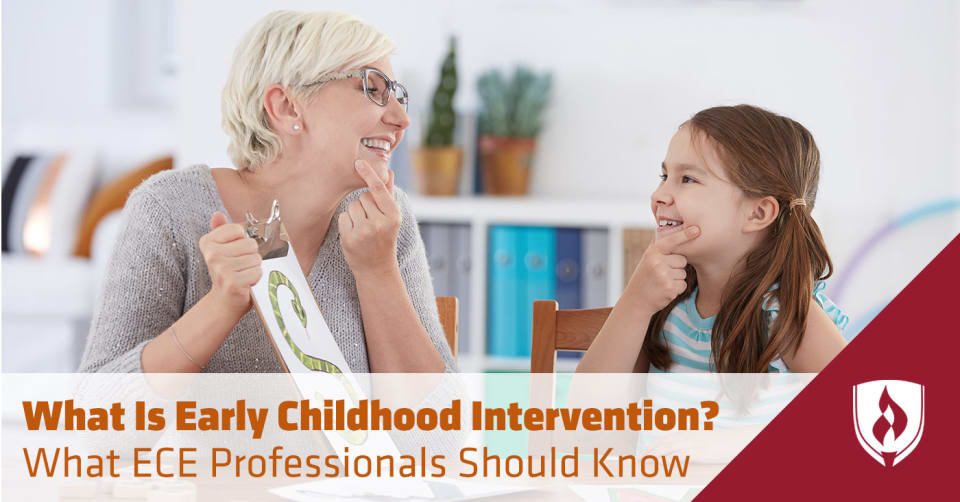What Is Early Childhood Intervention? What ECE Professionals Should Know
By Ashley Brooks on 09/09/2019

The word intervention makes you think of dramatic situations, like a group of people confronting their friend about an unhealthy behavior or a gossipy tabloid magazine cover announcing that a celebrity is back in rehab for the third time.
You probably don’t associate interventions with young children, but early childhood interventions are actually quite common. Though the word intervention might seem to have a negative ring to it, early childhood interventions are a good thing that provide huge benefits to children during the crucial years of early development.
If this information comes as a surprise, you probably have quite a few questions about how early childhood intervention works. Keep reading to discover answers about what early childhood intervention entails and how it can have lifelong benefits for children.
What is early childhood intervention?
Early childhood intervention—sometimes called simply early intervention—can be referred by any adult who has a concern about a child’s development, whether it’s a pediatrician conducting a formal screening or an attentive teacher or parent who observed something atypical. The goal of early intervention is to give children and families the support they need now, before a child has “fallen behind” in education or developmental expectations.
Early interventions are “programs that provide services and support for young children during their childhood years in order to prevent negative outcomes in the future,” explains Pedro Silva, founder and CEO of Küdos. “They are designed to aid and prevent [factors that] place children at risk for negative outcomes.”
Identifying children for early intervention
If you’ve ever taken a child to the pediatrician for a checkup or had a conference with a childcare provider, you know that ECE professionals are constantly keeping an eye out for potential developmental problems in little ones. They’re on the lookout for clues that kids aren’t developing as expected in one area or another, which can be signs that more support is necessary.
Parents who have noticed or been alerted to a possible concern in their child’s development are encouraged to call their state’s early intervention program. These government-sponsored programs connect parents with early intervention specialists who can more fully assess a child for underlying issues. These specialists create an early intervention plan to assist children and their families and connect them to any outside resources that might help.
Types of early intervention
There are many different types of intervention to meet the needs of different children. For example, a child with ADHD will need different support than a child with autism. These are some examples of the services that may be available to children as part of early intervention:
- Speech therapy
- Physical therapy
- Occupational therapy
- Psychological services and counseling
- Sensory integration therapy
- Dietary approaches
- Alternative learning methods
- Medication
ECE professionals who regularly spend time with children, like teachers or child care providers, also play a vital role in the success of early intervention. “ECE intervention professionals are critical to ensure that the intervention is strengthening the child’s process of learning so that the child feels secure and able to thrive in their environments,” Silva says.
Not only are these skilled professionals oftentimes the first people to notice that an intervention is necessary, they can also monitor a child’s progress and notify parents or other professionals if there are any changes. They work together with parents to give children their best opportunity for success as they grow older and enter the school system.
“Teachers and parents can be vital to aid the child in their transition into primary school, so they are more equipped and prepared to learn with their full potential,” Silva says.
Benefits of early intervention
There are undeniable benefits to getting children the support they need at a young age rather than waiting until the elementary school years. This is largely due to the rapid growth a child’s brain undergoes from birth to age three. “The connections in a baby’s brain are most adaptable in the first three years of life,” writes the Centers for Disease Control and Prevention (CDC). “These connections, also called neural circuits, are the foundation for learning, behavior and health. Over time, these connections become harder to change.”1
The CDC reports that early intervention is most likely to be effective earlier in a child’s life rather than later, leading to many improvements that are noticeable as a child moves into school.1 “Short-term benefits [of early intervention] often include primary school readiness, increased learning and school performance, better health and nutrition, as well as a safer and more supportive home environment,” Silva says.
Those benefits of early intervention are no small thing, and they continue to expand exponentially as a child gets older. Silva adds that in addition to educational benefits, early intervention can reduce instances of crime, drug use and teen pregnancy as children grow into adolescents and young adults.
Early intervention can positively impact a child’s entire path in life. The parents, ECE professionals and early intervention specialists who go the extra mile to give young children the support they need are everyday superheroes, doing work that literally changes lives.
ECE professionals supporting young children
ECE professionals offer caring support and resources to children and families, both through identifying the need for an early childhood intervention and walking alongside children who are following an intervention plan.
However, developmental delays aren’t the only concern ECE professionals are navigating in their classrooms. Learn more about the achievement gap and how it impacts ECE classrooms across the nation in our article, “What Is the Achievement Gap and What Can Educators Do About It?”
1U.S. Department of Health & Human Services, Centers for Disease Control and Prevention, “Why Act Early if You’re Concerned about Development?” [accessed August 2019] https://www.cdc.gov/ncbddd/actearly/whyActEarly.html




